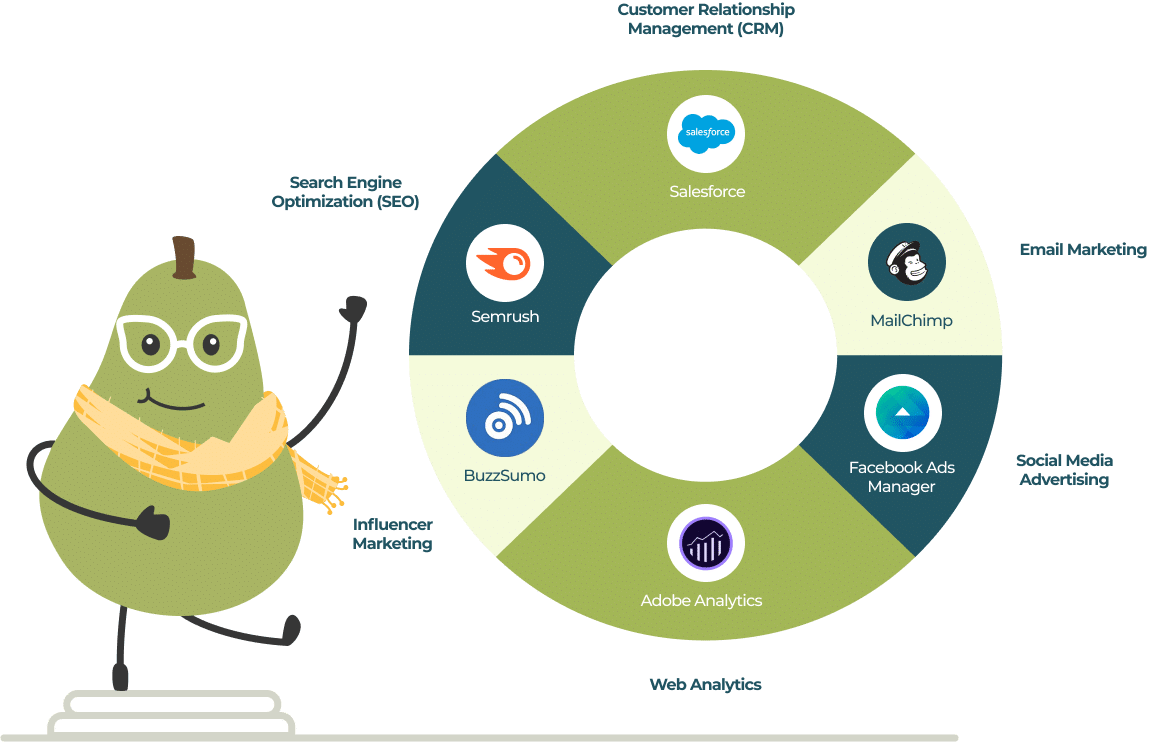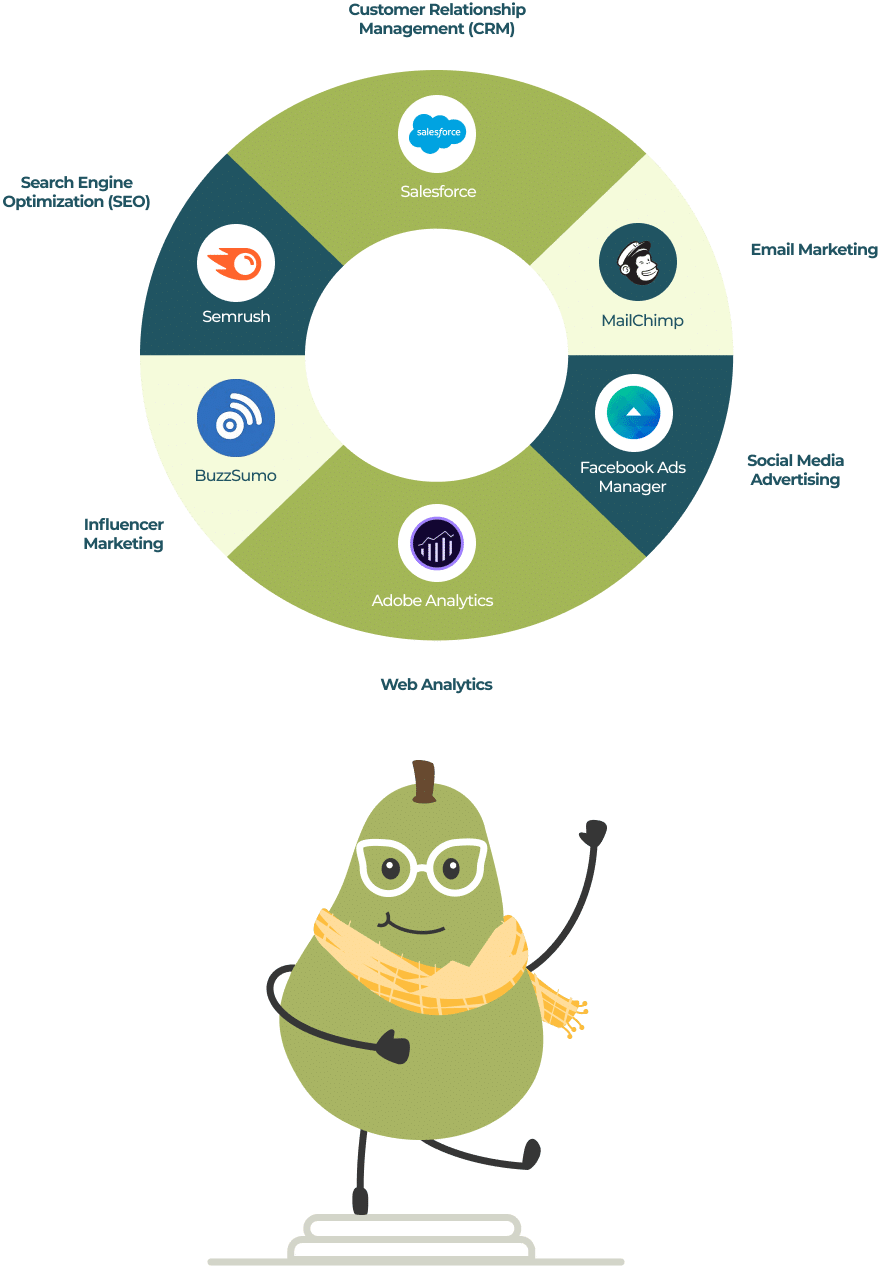You're in the right place if you’ve ever wondered how businesses keep up with the fast-paced digital landscape. This post is your one-stop guide to everything MarTech.
MarTech isn’t just a buzzword; it’s the heartbeat of modern marketing strategies. It empowers businesses to navigate the complexities of the digital world, turning the daunting into the doable
What is MarTech?
MarTech, short for Marketing Technology, is like the Swiss Army knife in a marketer’s toolkit. It’s a broad term encompassing all the digital tools and software that make our marketing activities more efficient and effective.
Imagine manually trying to keep up with your social media posts, email campaigns, content creation, SEO, and data analysis. Sounds exhausting. That’s where MarTech comes in. With the right marketing technology mix, these tasks become automated, streamlined, and much easier to manage.
So, whether you’re a small business owner wearing multiple hats or a member of a large marketing team, MarTech is your secret weapon for staying on top of your game in the fast-paced digital world.

What is the difference between MarTech and AdTech?
MarTech, short for Marketing Technology, refers to the digital tools and software marketers use to streamline and automate their marketing activities. MarTech aims to improve efficiency, understand and engage with customers, and optimize marketing strategies.
On the other hand, AdTech, short for Advertising Technology, is all about the technologies that enable programmatic ad buying and selling. AdTech allows companies to target very specific audiences, reducing wasted spending on advertising.
While both MarTech and AdTech aim to improve marketing outcomes, they serve different purposes. MarTech is more about nurturing leads and moving them through the sales funnel, while AdTech is focused on reaching potential customers through targeted advertising.
Examples of technologies and tools used in marketing
Customer Relationship Management (CRM): Salesforce is a leading CRM tool that helps businesses manage and analyze customer interactions and data.
Email Marketing: MailChimp is a popular email marketing platform that allows businesses to design, send, and track email campaigns.
Social Media Advertising: Facebook’s Ad Manager is a powerful tool for creating, managing, and measuring the performance of ads on Facebook and Instagram.
Web Analytics: Adobe Analytics is a comprehensive analytics platform that provides insights into web traffic and user behavior.
Influencer Marketing: BuzzSumo is a tool that helps businesses find influencers in their industry and track the performance of their content.
Search Engine Optimization (SEO): Tools like SEMRush and Ahrefs help marketers optimize their content for search engines, track keyword rankings, and conduct competitor research.
Remember, the right mix of marketing technology can help streamline your marketing efforts, improve efficiency, and provide a better experience for your customers.
How to Build a Marketing Technology Stack


Identify your primary marketing strategies and goals
What are your business goals? Are you looking to increase brand awareness, boost sales, or perhaps improve customer retention? Your marketing objectives should align with these business goals.
Next, consider your strategies. If your goal is to increase brand awareness, you might focus on content marketing or social media marketing.
If you’re looking to boost online sales, email marketing or SEO strategies might be more appropriate.
Once you’ve identified your strategies and objectives, you can start to look for the MarTech tools that will best support them. Remember, a MarTech stack aims to make your marketing efforts more efficient and effective. So, choose your tools wisely!
Set out the challenges that these goals involve
Once you’ve identified your marketing strategies and objectives, the next step is to tackle the challenges with these goals. Challenges are often time-consuming, repetitive, or not easily accessible tasks that can be performed by software.
Some common challenges you might face are: Data Management (collecting, analyzing, and making decisions based on data), search for information such as keywords or market analysis, constant publishing of content, etc.
Every challenge is an opportunity for growth. A good way to identify these challenges is to meet with your team and listen to their opinions, know the processes of each task, and keep up to date with the activities being performed.
Determine a budget and look for tools that fit it
This is a crucial step because, while there are many fantastic MarTech tools out there, they come with varying price tags.
Start by understanding how much you’re willing to invest in your MarTech stack. This will largely depend on your business size, goals, and the return on investment you expect from these tools.
Don’t be discouraged if budget is an issue; many free tools can help you with your work. Even the big ones have free options that work very well. However, if you are part of a large company or handle a lot of data, you may have to invest to have tools that make the grade.
Once you have a budget, you can start researching tools that fit within it. Look for tools that meet your strategic needs and offer the best value for your investment. Consider factors like the tool’s features, ease of use, integration capabilities, and customer support.
Consider trainings and assign a person from the team
Implementing new marketing technology tools often requires training to ensure your team can use them effectively (and yes, this should also be included in your budget). The goal is to empower your team to leverage these tools to their full potential.
Assigning a dedicated person to manage each tool you have chosen for your MarTech stack is also crucial. This person will oversee the implementation of new tools, manage integrations, monitor performance, and troubleshoot issues.
Not to mention that being a new tool, it is also on trial, so this person must decide whether it is the right tool.
MarTech Tips

Start Small and Scale: Instead of utilizing an entire set of tools simultaneously, initiate with a couple of crucial tools that address your immediate needs. You can incrementally incorporate more tools as your marketing strategies mature and diversify.
Integration is Key: Opt for tools that can integrate efficiently. Such interoperability assures a continuous data flow across your MarTech stack, enhancing productivity and performance.
Prioritize User-Friendly Tools: Select tools that are straightforward to handle. This approach minimizes the learning gap for your team and boosts the tool adoption rate.
Periodically Evaluate and Refresh Your Stack: The domain of marketing technology is perpetually dynamic. Hence, it is crucial to routinely reassess your MarTech stack to verify its relevance to your needs and to leverage any novel tools and features as they emerge.


